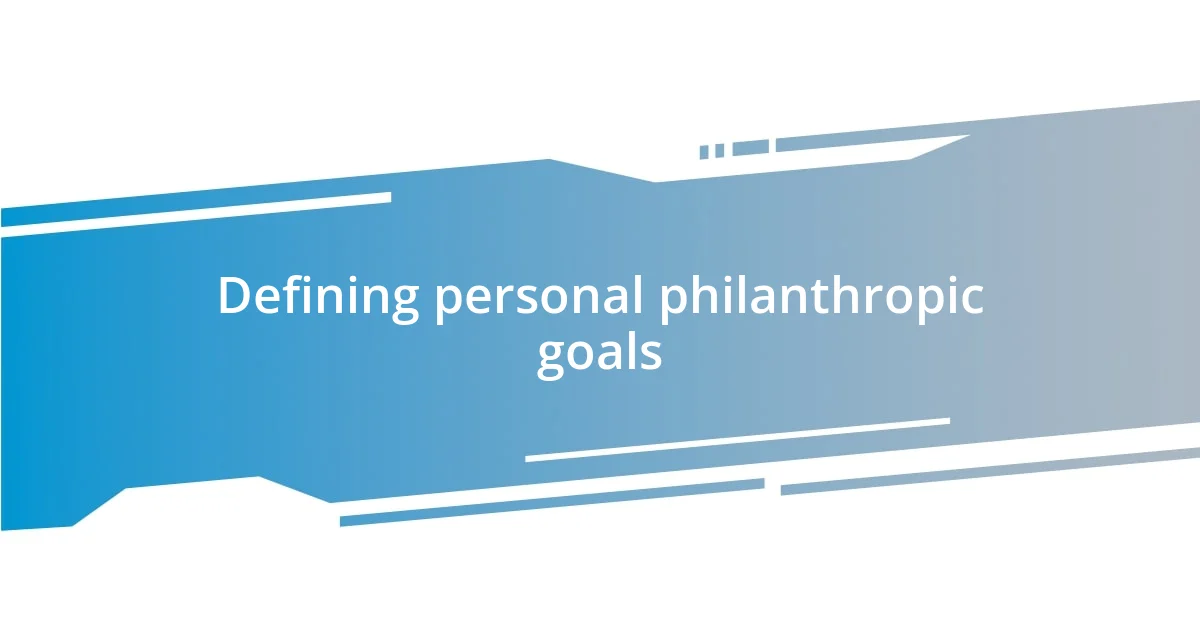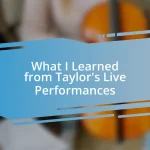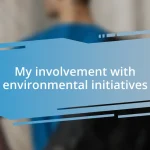Key takeaways:
- Philanthropy creates transformative change by providing resources and fostering community engagement, empowering individuals and breaking cycles of poverty.
- Defining personal philanthropic goals aligned with one’s values and experiences enhances the effectiveness and fulfillment of charitable giving.
- Storytelling and collaboration are powerful tools for engaging others in philanthropy, turning personal experiences into a collective movement for change.

Understanding philanthropy’s impact
Philanthropy has the power to transform lives and communities in profound ways. I remember visiting a local shelter where donations had not only provided basic needs but significantly upgraded their facilities, offering those in crisis a sense of dignity. Isn’t it incredible how something as simple as a warm meal or a safe place to sleep can spark hope and change?
When I think about the larger impact of charitable giving, I often wonder—how do our contributions ripple through the fabric of society? For instance, when I supported an education initiative, I saw firsthand how access to resources like books and technology opened doors for underprivileged youth. This kind of investment can break cycles of poverty and foster new generations of change-makers.
Moreover, philanthropy fosters a culture of giving that can be contagious. Once, I participated in a community project that encouraged local businesses to support families in need. Witnessing the engagement from the community was uplifting; it made me realize that when we pool our resources, we not only tackle immediate problems but also inspire others to join the cause. Isn’t that what real impact is all about—building a collective movement toward a better future?

Defining personal philanthropic goals
Defining personal philanthropic goals is an essential step for anyone looking to make a meaningful impact. I’ve found that clarity in one’s mission often leads to more effective giving. After I took the time to reflect on my values and priorities, I realized that supporting environmental sustainability resonated deeply with me. That decision guided my contributions and allowed me to focus on projects I was genuinely passionate about.
To help clarify your philanthropic objectives, here’s a simple list of points to consider:
- Identify causes that resonate with your values: What issues tug at your heartstrings?
- Assess your skills and resources: How can you leverage what you have to make a difference?
- Set realistic and measurable goals: What specific outcomes do you want to achieve?
- Reflect on past experiences: Which projects or initiatives have left a lasting impression on you?
- Seek feedback: Engage with others involved in philanthropy; their insights can refine your direction.
By establishing personal goals, you not only enhance your own giving experience but also pave the way for genuine, targeted impact in the community.

Identifying causes that resonate
Identifying causes that resonate is a deeply personal journey for any philanthropist. For me, it began with reflecting on my own experiences and the issues that sparked my passion. I remember when a close friend faced homelessness; her struggle opened my eyes to the systemic issues around housing. Since then, I’ve committed to supporting organizations that emphasize affordable housing solutions, feeling a connection to those seeking stability.
One thing I’ve realized is that passion drives genuine giving. When I volunteered at a local animal shelter, I witnessed how crucial it is to advocate for animal welfare. The joy I felt walking those dogs—knowing they were getting a chance for a better life—was overwhelming. It propelled me to invest not just my time, but also my resources into programs that promote adoption and animal care. The experience taught me that when you align your giving with what truly stirs your heart, the impact is exponentially greater.
It’s also important to explore how these causes align with your skills and experiences. For instance, I have a background in education, so supporting literacy programs felt like a natural fit. As I partnered with a local initiative, I shared stories of my own struggles with learning to read as a child. That connection with the beneficiaries made it clear—when your life story intertwines with your philanthropic goals, it creates a powerful narrative of change.
| Cause Type | Personal Resonance |
|---|---|
| Homelessness | Connection to friend’s experience |
| Animal Welfare | Joy from volunteering |
| Education | Aligning with my background |

Establishing sustainable giving strategies
Establishing sustainable giving strategies is something I’ve thought a lot about, especially in terms of creating lasting impact. One approach I found effective is to commit to a regular giving schedule, which helps streamline my donations and ensures that my support is consistent. For instance, I started donating a set amount monthly to a local environmental conservation group; this not only holds me accountable but also allows the organization to plan their projects with more financial certainty.
Engagement is key to sustainability, and I’ve experienced firsthand how active involvement can lead to deeper connections. After joining a nonprofit board, I realized how much more enriching it was to contribute not just money, but also time and knowledge. This dual approach of giving meant that I had a say in how funds were used, and it combined my passion for service with strategic outcomes. Have you ever considered how much more impactful your giving could be if you paired financial contributions with volunteer work?
One strategy I’ve implemented is to align my contributions with specific, measurable outcomes. For example, when I supported a local food bank, I committed to funding an initiative that offered cooking classes. I was fascinated to see how my investment grew into a program that not only alleviated hunger but also empowered participants with skills for healthier living. By focusing on tangible results, I felt my contributions were not just fleeting moments of generosity, but stepping stones towards lasting change.

Measuring the effectiveness of donations
Measuring the effectiveness of donations can feel like trying to navigate a complex maze. I’ve often wondered how to quantify the impact of my contributions. For instance, when I supported a mental health initiative, I noticed the program tracked improvements in participants’ well-being through surveys and follow-ups. Witnessing these tangible results gave me a sense of validation for my support; it was gratifying to know my donation contributed to genuine, measurable change.
In my experience, it also helps to evaluate the efficiency of an organization. I remember when I chose to donate to an international clean water project. They published regular updates highlighting how funds were allocated and the direct results achieved. Seeing the number of people served and water sources created made it easier for me to assess whether my financial support was being used wisely. Have you ever paused to think about how organizations track their progress? A clear reporting structure can help reassure me that my donations are making a difference.
Lastly, I believe that connecting with beneficiaries provides personal insight into the donation’s effectiveness. I visited a community health clinic that I had supported, and speaking with individuals whose lives had been transformed made the impact vivid and personal. Their stories transformed abstract numbers into heartfelt experiences, which deepened my commitment. This encounter raised an important question for me: How can we truly measure impact if we don’t listen to those who benefit directly from our contributions? That live feedback motivates me to keep giving with intention.

Engaging others in philanthropy
Engaging others in philanthropy often starts with storytelling. I remember hosting a small gathering where I shared my experiences volunteering at a homeless shelter. The stories I told weren’t just about the challenges the individuals faced but also about their resilience and hope. That night, several friends expressed their desire to get involved, and it warmed my heart to see them inspired to take action. How powerful is it, I thought, to connect through personal stories that resonate on an emotional level?
Another effective way I’ve engaged others is through collaborative projects. I initiated a community clean-up day and invited friends to join. It was amazing to see how the event transformed not just the park we cleaned but also our relationships. Working side by side, we not only tackled an environmental issue but also forged new bonds. Have you ever considered how shared experiences can amplify the impact of philanthropy? Those collective efforts can create a ripple effect, encouraging others to give back as well.
Finally, I’ve learned the importance of providing avenues for others to contribute based on their interests and skills. For instance, when a friend, an excellent graphic designer, offered to create promotional materials for a local charity, it opened my eyes to how people want to contribute in ways that resonate with them. I encouraged others to leverage their unique talents for philanthropic causes, which created a diverse pool of support. Isn’t it rewarding to think that philanthropy isn’t just about money? It’s about harnessing the talents and passions of everyone to create a more impactful change.

Sharing your philanthropic story
Sharing my philanthropic story has always felt like weaving a tapestry of my experiences and lessons learned. One moment stands out vividly: when I organized a fundraiser for a local animal shelter. As I recounted my own journey of rescuing a stray dog, I saw tears in the eyes of the attendees. This connection transformed us from mere supporters into a united group, driven by a shared passion for animal welfare. How incredible is it to see how personal anecdotes can foster community and inspire collective action?
In another instance, I chose to write a blog post detailing my experiences mentoring youth in underserved neighborhoods. It was both nerve-wracking and exhilarating to lay bare my struggles and the joy of watching these amazing kids thrive. I received messages expressing gratitude from readers who wanted to volunteer or donate. Have you had a similar response when opening up about your own philanthropic journey? Sharing my story turned into a catalyst for others to find their own paths to giving back.
Moreover, I’ve discovered that using social media to share updates on the organizations I support can create a ripple effect. When I posted about a recent charity walk, not only did my friends cheer me on, but they also started sharing my posts with their networks. I couldn’t help but wonder: could this small act of sharing be a stepping stone for someone else to begin their philanthropic voyage? I learned that every story has the power to ignite change, and sometimes, all it takes is one person’s willingness to share their journey.














